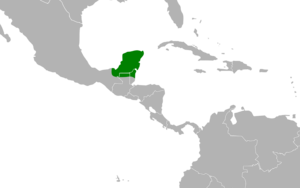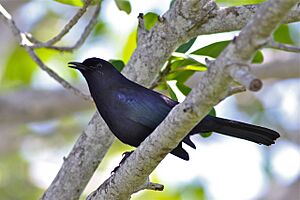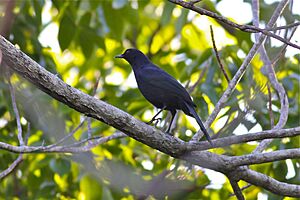Black catbird facts for kids
Quick facts for kids Black catbird |
|
|---|---|
 |
|
| Conservation status | |
| Scientific classification | |
 |
|
| Synonyms | |
|
The black catbird (Melanoptila glabrirostris) is a cool songbird found only in a special part of Central America called the Yucatán Peninsula. It's the smallest bird in its family, called Mimidae, which includes mockingbirds and thrashers. This bird is about 19–20.5 centimeters (7.5–8.1 inches) long and weighs about 31.6–42 grams (1.1–1.5 ounces). Both male and female black catbirds look alike, with shiny black feathers, black legs and beak, and dark brown eyes. They live in low-lying areas, from bushy lands to forests with lots of plants close to the ground.
Even though it's a mimid, the black catbird doesn't copy other birds' songs. Its own song is a mix of harsh sounds and clear, flute-like whistles. It builds a cup-shaped nest in low bushes or trees and lays two bluish eggs. Sadly, its home is shrinking, so it's considered near threatened by conservation groups.
Contents
Understanding the Black Catbird's Name
When Philip Sclater first described the black catbird in 1858, he gave it the scientific name Melanoptila glabrirostris. He also created a new genus (a group of similar species) just for this bird, called Melanoptila.
What Does Melanoptila Mean?
The genus name Melanoptila comes from two Ancient Greek words. Melas means "black," and ptilon means "plumage" (feathers). This name clearly refers to the bird's black color.
What Does Glabrirostris Mean?
The species name glabrirostris comes from two Latin words. Glaber means "smooth or hairless," and rostrum means "beak". This part of the name describes how the black catbird's beak has very small bristles around it. This is different from the gray catbird, which has much more noticeable bristles.
What Does the Black Catbird Look Like?

The black catbird is the smallest bird in the mimid family. It's about 19–20.5 cm (7.5–8.1 in) long and weighs 31.6–42 g (1.1–1.5 oz). It has short, rounded wings and a fairly long tail.
Both male and female catbirds look similar. Their feathers are shiny black with a purplish color. Some parts, like their tail feathers, might have a greenish shine. Young birds are brownish-gray. Their legs are black, and their beak is also black and shorter than their head. The eyes of adult birds are a dark reddish color, while young birds have gray eyes.
How to Tell it Apart from Similar Birds
While the black catbird is unique, other black birds live in the same areas. These include the melodious blackbird, the bronzed cowbird, and the giant cowbird. However, these other birds usually live in more open spaces.
- The melodious blackbird is bigger and has a longer tail.
- The bronzed cowbird has a thicker neck and a bronze shine to its feathers, not purple or green. Its eyes are bright red.
- The giant cowbird is much larger and has a longer tail and thicker neck than the catbird.
Where Do Black Catbirds Live?
The black catbird lives only in the Yucatán Peninsula. This area includes parts of Mexico (like Campeche), northern Guatemala, and northern Belize. You can also find them on islands near the coast, such as Cozumel and Ambergris Caye.
Historically, there were a couple of records of black catbirds in Honduras and Texas. However, they haven't been seen there since, and some experts think those records might have been mistakes.
What Kind of Places Do They Like?
Black catbirds prefer low-lying areas that can be dry or humid. They live in places like scrubland, old farms, and the edges of woodlands. They especially like areas with thick bushes or dense plants close to the ground. They don't usually live in tall forests where the plants underneath are more spread out. These birds mostly stay in one place, but they might move a little during late summer or early winter if their northern homes get too dry.
Black Catbird Behavior
Their Unique Voice
Unlike many of its relatives, the black catbird doesn't copy the songs of other bird species. Its song is made of repeated phrases that can sound harsh, scratchy, or like a flute. It often adds metallic clicking sounds. They usually sing from high, open spots. They also have different calls, some of which sound like the gray catbird's calls. These calls are described as a harsh rriah, a nasal chrrh, or a grating tcheeu.
What Do Black Catbirds Eat?
Scientists haven't studied the black catbird's diet much. However, like its close relatives, it's believed to be an omnivore. This means it eats both plants and animals. They are known to eat fruits from trees like Bursera simaruba and Ficus cotinifolia, which grow in tropical areas.
How Do They Raise Their Young?
Not much is known about how black catbirds raise their families. Their breeding season seems to be from spring through summer. Nests have been seen in Belize in early May, and young birds were found in a nest in Mexico in mid-August.
The nest is shaped like an open cup. It's built from twigs and lined with roots and other soft materials. They place their nests low down in a dense bush or a small tree. The female lays two greenish-blue eggs. However, many details, like how long the eggs take to hatch or how parents care for their young, are still a mystery.
Protecting the Black Catbird
The area where black catbirds live is small and getting smaller because their habitat (their natural home) is being destroyed. In 2008, experts thought there were fewer than 50,000 black catbirds left, and their numbers were still going down. Because their population is shrinking so quickly, the International Union for Conservation of Nature has listed the species as near threatened.
Another problem for the black catbird is the arrival of the shiny cowbird. Shiny cowbirds are brood parasites, which means they lay their eggs in other birds' nests, leaving the host bird to raise their young. This could cause problems for the black catbird if it becomes a target for the shiny cowbird.



